So, what is it that will grab our attention when we look at a photograph? Is there any one thing? If we don’t understand what has that special zip and why, we will never be able to produce those kinds of images ourselves on a consistent basis.
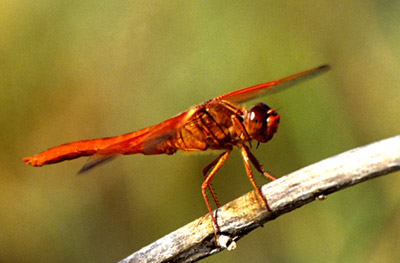
I’m a very goal-oriented person. If I set out to do something, I tend to be impatient with myself until I get the job done.
It’s a continuous job working on ones website and supplying images for the site means making choices. While working on this project, I want those images to do some really “strong lifting” and grab the viewer’s eye. I want people to look at those opening images and say, “WOW … I want to see more!”
Here are some basic thoughts and ideas that you might want to check out in your own images:
1. What is the subject or purpose of the image? It is amazing how many images are created with only the vague idea that it was pretty or that here it was or I was there… If you don’t have a strong subject, make the choice to find one.
2. Did I present my subject with clarity? Clarity is so important because if a viewer can’t see what you did or are trying to do or say, why will they be attracted to your image? Be specific and be obvious in your presentation. The audience isn’t able to guess what you were “trying to say” with your image, they have to be shown.
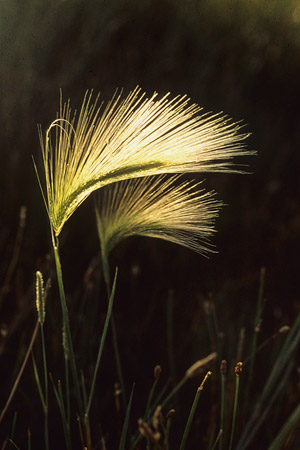
It is very fair to say that you need to work your subject to get the best possible shots. While driving along a dirt road I saw this stunning backlit weed.
The sun was about to set and the glow on the subject was magnificent. I started to photograph moving in various directions to get the image that I desired.
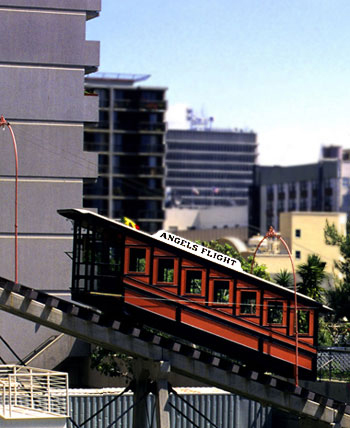
I wanted to depict a time from the past surrounded by the present. This is the shortest railway in the world (315 feet long) and it is located in the heart of downtown Los Angeles. It opened in 1901, when the cost of a ride was one cent. The funicular system consists of two counterbalanced cars moving up and down the steep, 33% grade, Bunker Hill.
3. Is the subject emphasized in the composition? There are many elements of design (light, color, value, line, shape, texture/pattern, etc) to consider when creating your composition. Did you make sure that the elements you are using actually draw your eye to the subject and emphasize that subject? Are they working together?
4. Did you remove all distractions that are in conflict with the subject? Little things make a huge difference. One of my favorite images that I had matted and framed in my home was a backlit fern leaf. I really loved that one and couldn’t understand why I rarely got any comments on it.
One day I looked hard and saw that there was an out of focus leaf in the background that looked like a big, bright yellow worm. I saw the fern, but what others saw and were disturbed by was “the worm”.
I allowed that out of focus leaf to steal the attention from the fern. I still keep that image on the wall (not where too many people can see it) because it is a great reminder for me to pay attention to the little things in an image.
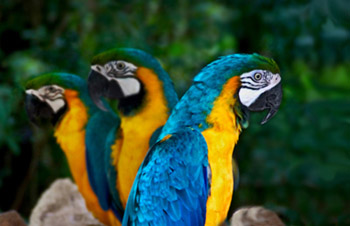
There is the wonderful Brazilian bird sanctuary very close to the world famous Iguasu Falls in Brazil. These three parrots gave us a warm greeting when we entered the park. It was amazing to see the variety of unusual birds and animals in the park. Well worth the visit.
The Central Valley of California in the winter time can be thick with Tule Fog (this is a particularly dense fog that may stay in the area for weeks). When driving in the area early one morning, the sun just started to break through and we had maybe 10 minutes to catch the reflections and mist.
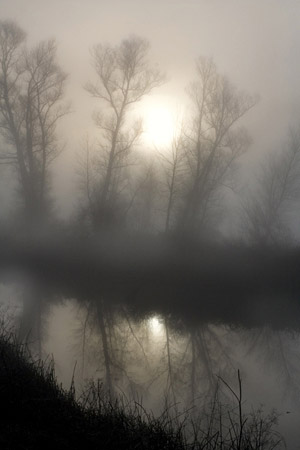
Our Photographic Choices
So what it comes down to is the choices we make in the field when taking the photograph. Yes, I know, it is possible to “fix stuff”, but why create something that you know will need to be fixed? Do it right in the first place … when you take the image! Those first choices can make a huge difference in the success or failure of the image.
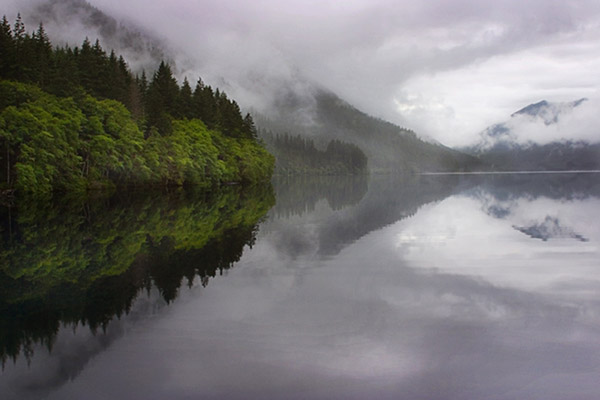
Early one morning I was driving along the lake headed out to the coast. The fog started to lift and the lake was like a mirror … not a ripple to be seen.
What a bonus for getting up and out early in the day. I used a 1/2 neutral density filter on the camera to equalize the sky and the reflection (image made on film).
Here is my short list of what I need to remember or do in the field:
1. What is the subject … is it the lake, the tree or the mountain?
2. What should I include and what should I exclude? Why?
3. Shall I make a vertical or horizontal photograph … or should I go nuts and tip-and-tilt the camera?
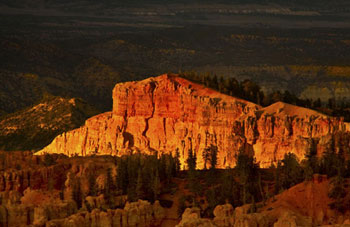
Bryce Canyon is beautiful all of the time, but when light peeks out from under heavy storm clouds at sunset, it paints the red and orange rocks with such warm light that they seem to glow. A perfect place for photographers!
Right: Farmland Path, Bavaria, Germany
I really enjoy driving little side roads and this one was lovely as we set out early one morning. It was secluded, peaceful and quiet and you know the path leads to more of the same. This also depicts a great example of the compositional element of “Lines”.
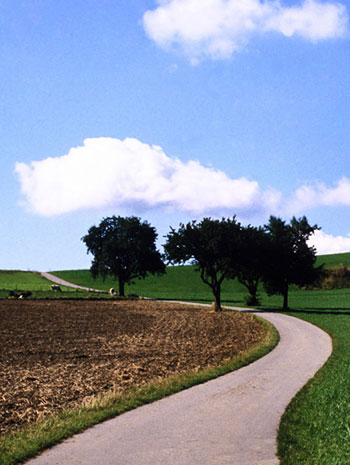
4. From what direction is the light coming and is it too bright or too dull. Can I make the lighting more dramatic by changing my position or waiting until it is later in the day, or should I get up earlier tomorrow?
5. Are lines leading to the subject? Do they distract and take my eye away from the subject? How do I get rid of them?
6. Should I take a lower view of the subject or a higher one?
7. Does everything in the photograph contribute to the overall drama of the image?
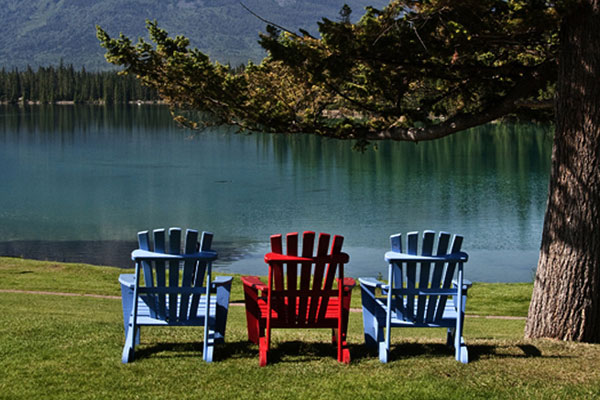
Jasper Park Lodge, Alberta, Canada
This lodge is situated on Lac Beavert and it was
delightful to spend a quiet afternoon overlooking the lake.
8. Did I get rid of everything that doesn’t work with the subject or distracts from it? Did I dump that out-of-focus, too bright blob that will pull my eye away from the beauty of the subject?
9. Is my exposure correct and am I using the correct depth of field and shutter speed to get the image I desire?
10. Did I photograph the subject from several points of view so I can have several selections from which to choose when I get home?
The Editing Process: What to do when You Get Home
I usually don’t try to edit in the field or while I am on a trip. I just review briefly to see that all cameras are functioning properly and leave the body of work to edit when I get home. So how do I make the choices needed about which photos to keep and which photos to discard?
How tight is my editing process? Can I keep my ego and emotions in check so I can look at my work with a critical eye and easily delete those so-so photos?
If an image isn’t taken right in the first place, and if the corrections aren’t minor, then I didn’t do my job as a photographer correctly! No matter how long one has been in the business of photography, we can all use a reminder to pull stored away knowledge back up to the foregrounds of our brains.
So, since I’m already in the process of finding what I feel are some of my “WOW” photos, this also gives me the opportunity to get tough with myself and really evaluate a whole lot of my work and glean them out of my files.
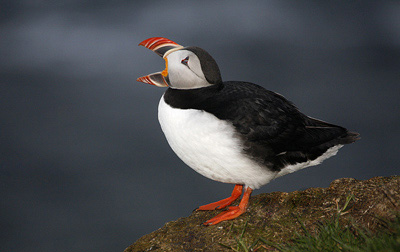
Cliffs of Latrabjarg, Western Iceland
Over half of the world’s population of Atlantic Puffins breed in Iceland. Puffins live and breed on the cliffs that mark the most western part of Europe. While the puffin looks fairly large, they are only about 6 inches in length and have very short wings for their size.
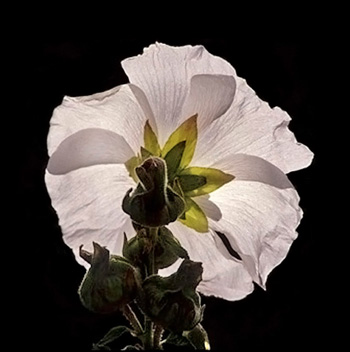
Lonely Graveyard, New Mexico
I was photographing pueblos when I saw this flower in an old graveyard. The light had almost dropped behind the adobe wall in the distance.
The flower was beautifully backlit and I used just a little bit of fill flash to get some detail in the stem.
For just a moment, let’s think about that process of editing. It is really a subject all of its own, but here are some of my new criteria for reviewing and editing my own work that might work for you too. Some of them are similar to the check list for taking the image that I listed above, but there might be a few new ideas for you.
1. What is right with this image?
2. What is wrong with this image?
3. Can the wrongs be easily fixed?
4. Did I show the viewer what I wanted them to see?
5. Are their major distractions?
6. Is it technically correct? Is it interesting to view?
7. How will it be used? (Print, on-line, for a client?)
8. Does it meet the criteria (and they can be different) for one thing and not another?
9. Does it go in my “idea” file so that I won’t forget the idea but will do it better next time?
10. If it isn’t working, did I toss it out?
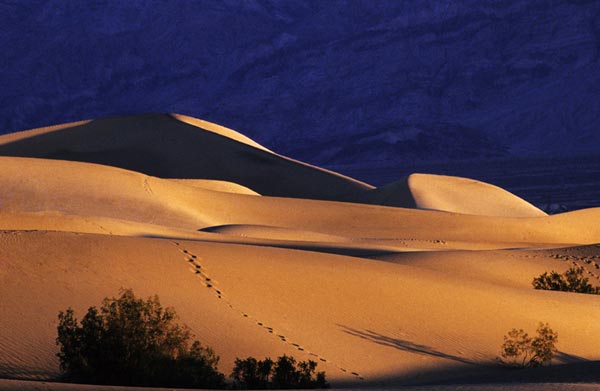
Death Valley Sand Dunes, California
Dawn on the sand dunes in Death Valley can be spectacular. I always get up very early and walk with my flashlight out to the dunes. As the dawn breaks and the sand turns brilliant colors, it is worth the walk and the wait.
The Challenge
Our photographic quest is all about making choices from start to finish, so I would like to present each of you with a challenge:
Select 30 of your favorite images … the ones that you think are terrific. Review them based on the lists above. If they meet the criteria you have made for yourself then keep doing what you are doing. If they don’t, figure out why and work on your weaknesses.
All of our goals should be to make dynamic, exciting images that everyone will want to see!
by Noella Ballenger
© 2015 Noella Ballenger. All rights reserved. (Updated and revised 2010 article.)

Leave a Reply